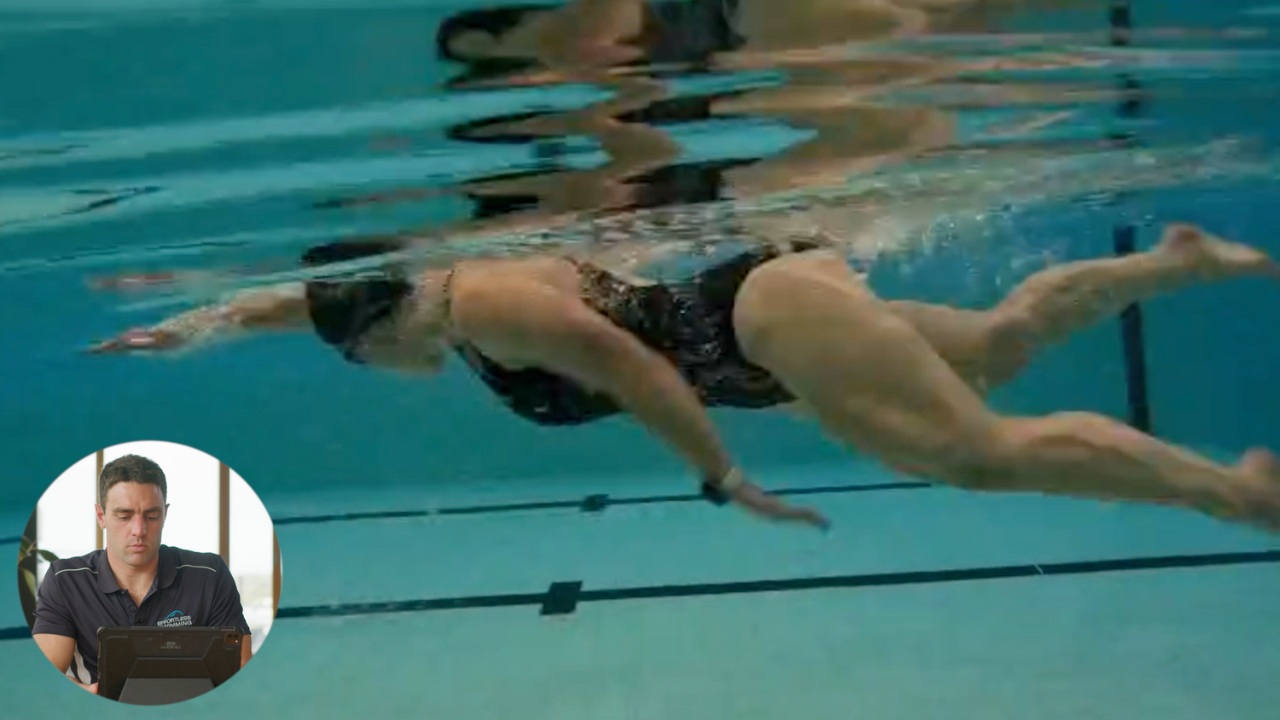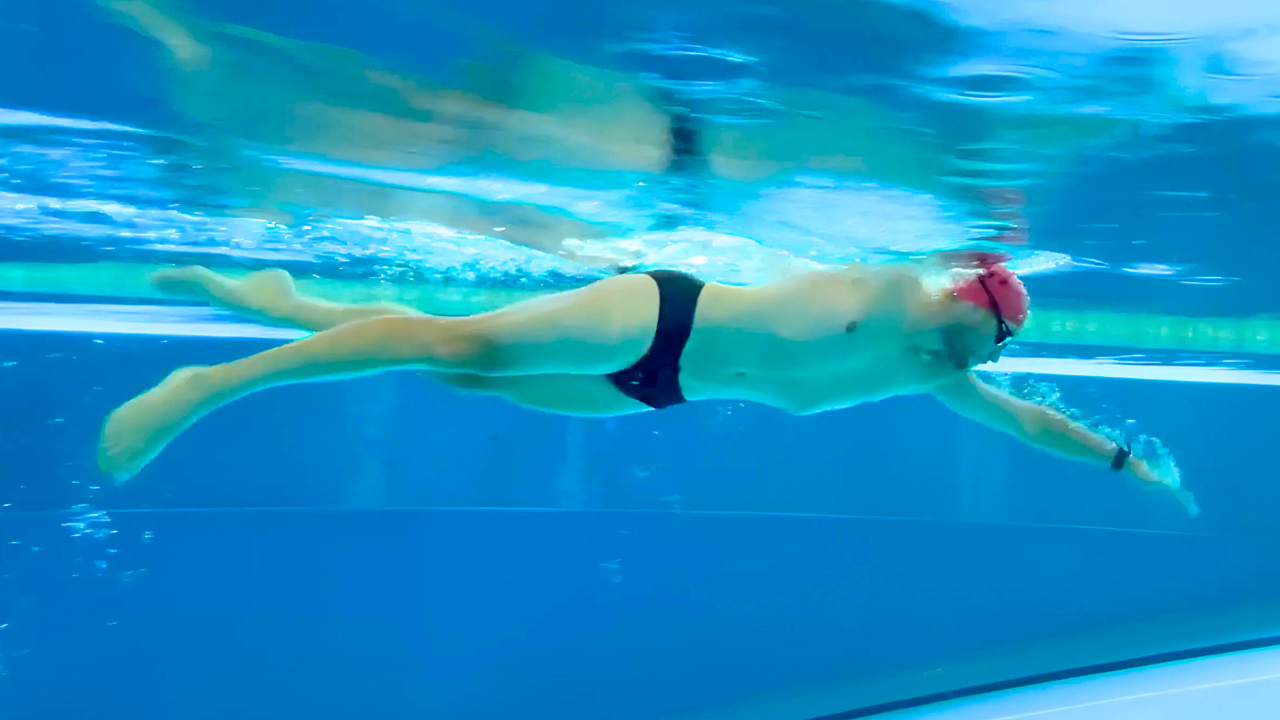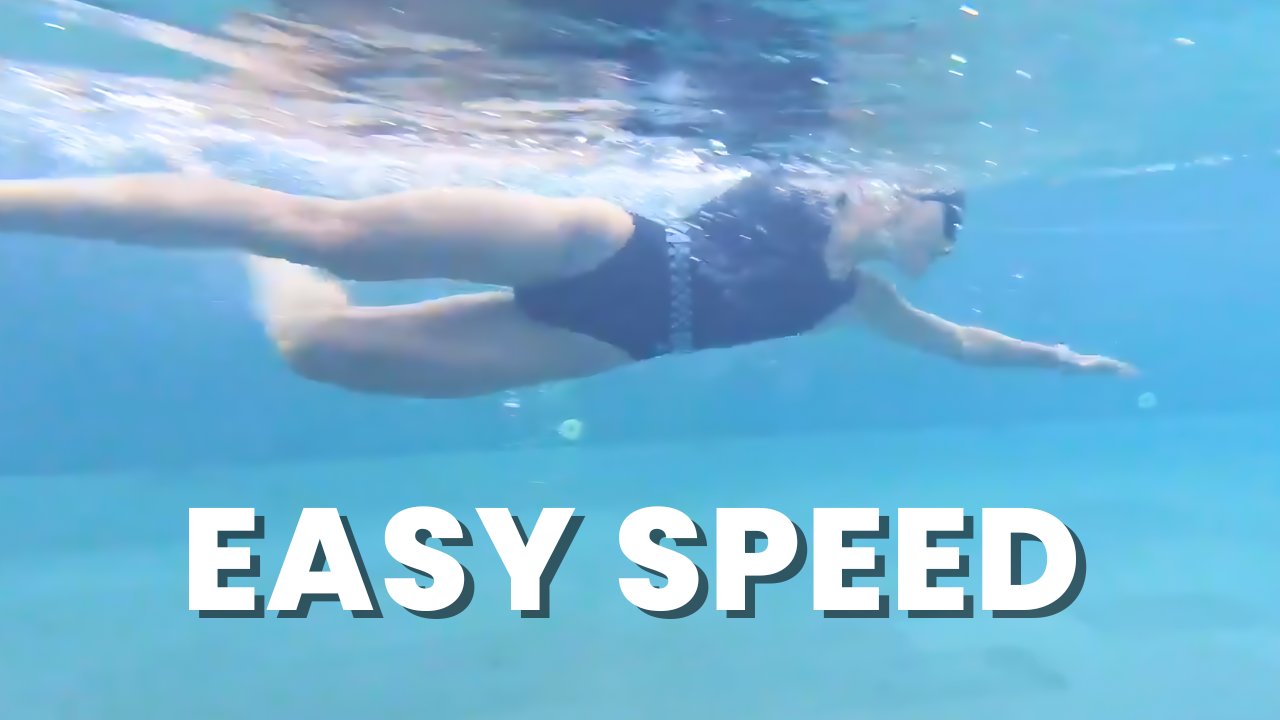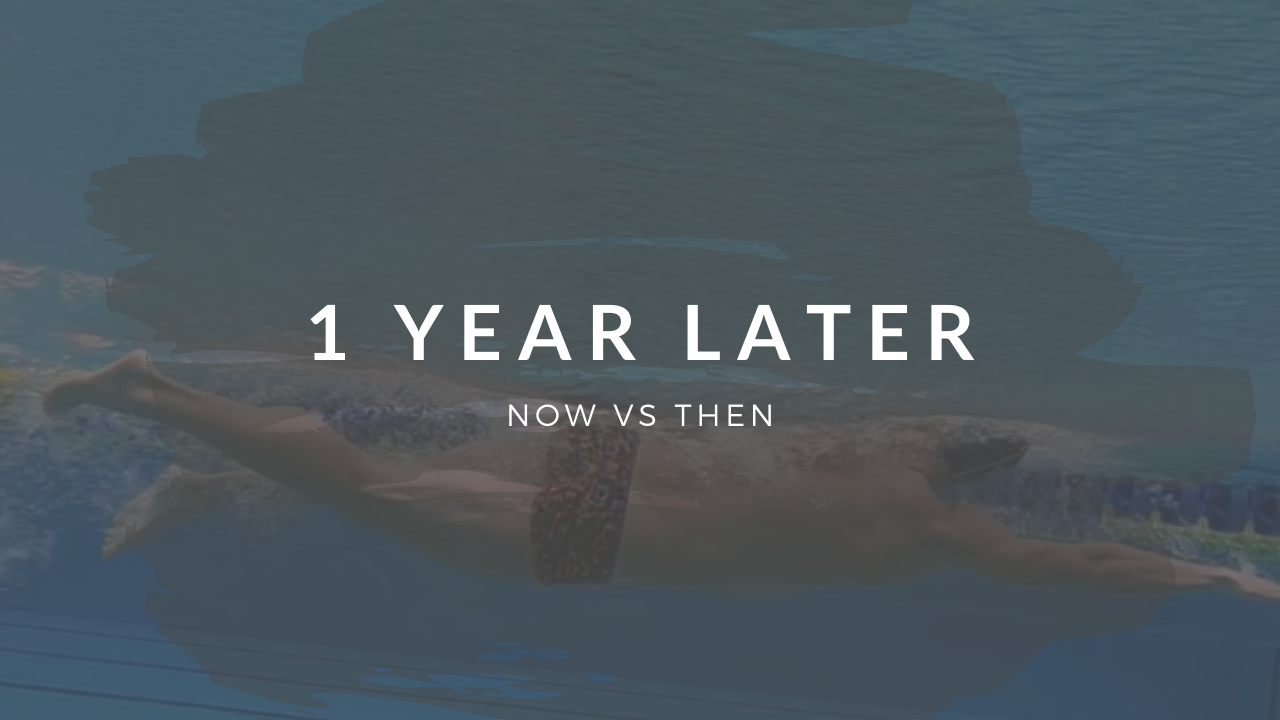In today’s Feedback Friday, we look at a 19-year old with a cycling background who has recently turned to triathlon. He’s currently at 28 minutes for his half ironman swims. Let’s look at what will help him bring that under 25 minutes.
Transcription:
… insweep here towards the center then outsweep back to the hip. We want to swap that round. We want to have a slight outsweep in the beginning and then an insweep toward the back.
Hey, Brenton here from Effortless Swimming. This is a Feedback Friday. If you haven’t seen this series before this is where we analyze someone’s stroke. We look at what they can do to improve their technique, and swim faster, and save energy at the same time. If you are looking to have your own analysis done we run swimming clinics in Australia. We run camps in Thailand, Hawaii, and in Noosa in Queensland. We also do online coaching for athletes where we work with them on a regular basis to help them refine their stroke and swim faster. You can see the links for those below.
Now this swimmer here, his name’s Will Draper. He’s 19, comes from a cycling background. He’s currently swimming around the 1:30 mark for his half Ironman swims. We’re going to look at what could he do over the next 12 to 24 months to be competitive in the swim and really be in that front pack? Swimming, like any skill, takes time and it takes work. We’re going to look at what are those technical things that he could do to get towards that front pack?
The first thing that stands out here is stroke rate, and he mentioned this in his email, that the stroke rate is 60 strokes per minute. One stroke per second. Now anyone who’s in the front pack they’re going to be around the 70 to 85 strokes per minute mark, so somewhere in that range. 70 to 85 strokes per minute for his age group and that distance. Over time we’d want to be building up towards that. If he can maintain pretty good distance per stroke and even just in the next three to six months be around the mid-60s to high 60s that will certainly make a big, big difference. Especially in open water we find that a slightly faster rating can be beneficial there as well.
What could he do to increase his stroke rate? Well, some of the technical things that I’ll talk about, that will make it easier to do this, but another thing that can certainly help is using a Finis Tempo Trainer to just get used to matching that faster rating. Let’s say in his swims he might be doing a set of 12 100s, 15 100s at half Ironman pace. What he could do is get the Tempo Trainer, he could set it to 63 or 64 strokes per minute. He could do those race pace sets holding that sort of rating. Over the course of a couple of weeks just bump it up by one extra stroke per minute. By the time he’s 12 weeks, 16 weeks, into it he could be around the 68, 68 strokes per minute mark and he won’t really notice a difference. It takes time to be able to do this or to be able to increase it, so you want to be able to give yourself that time. Incrementally improve it. You don’t want to go from 60 up to 75, it’s not going to be sustainable. That would be the first thing.
Now the other thing we’re looking at here technically the breathing. It looks like he may be holding his breath a little too much here. You can see that there’s maybe a light exhale through the nose, only just. But then when he turns his head to breath it doesn’t look like it’s quite forceful enough on the exhale. We’re looking here, yeah a bit of exhale, so it’s not too bad there. But there is a good chance he might be holding his breath a little bit. I would encourage just a little bit more of an exhale through the nose as his face is in the water. Not too much, just a little bit. But then right here we want to have a bit more of an assertive exhale. That can certainly help. Just clear the lungs, empty the lungs a bit more, and just allows you to avoid that buildup of CO2. It can make things feel a bit easier as well.
Now one of the reasons why he might be having … Or his breath might be held there a little bit is if we look at the head position. The head tends to duck quite low after the breath. We’re getting a breath here. Then you’ll notice this position here. Head starts to come under the water quite a bit. He’s even looking maybe a bit far down. Then the head lifts up. We go from down here to coming back up. You can see that’s quite a bit of an arch through the spine there. The head tends to move around quite a bit. You can actually see there he’s starting to look behind him. He’s starting to look back from straight down. What I’d encourage there is we want to keep the head generally fixed. It’s okay to move up and down a little bit but we don’t want to move it side to side, unless we’re turning to breathe. But generally keep the head or the eyes fixed in a position that you’ll hold for pretty much the whole race.
That is, of course, unless you’re sighting or you’re looking at feet in front. But I’d encourage him to look somewhere around … It might be here. We like to talk about being anywhere from straight down to 45, but being a triathlete, being an open water swimmer, somewhere in that upper range is probably where he’d be best. But as long as you feel like your neck is being extended and kept long that’s one of the main things we want to keep there. We want to try and avoid having the chin come too far forwards where we get this kink in the neck. That can really impact the posture.
We, generally, want to try and avoid too much of an arch through the lower back there. By thinking of lengthening through the back of the neck, sucking the tummy in, engaging the glutes slightly, this can keep the spine a little bit straighter. It can just allow better connection through the middle of the body, so more tightness through the middle of the body. It helps you connect out the rest of the stroke. In terms of posture, we mentioned this on the last Feedback Friday, but a lot of it will start with the head position. Also the light engagement through the core, light engagement through the glutes, and that can keep this fairly straight. That will be the second thing there. We’ve got the exhale. We’ve got the head position, looking to keep that a little more fixed instead of moving it up and down too much.
Now one of the things that also might be contributing to the up and down movement, if we look from above … I’m not sure if we get the complete top view. You can see it from the front here though. There’s a bit too much of a crossover happening here. You’ll see that this right hand enters in front of the head, comes across a little bit too much. Then it has to drift out, drift out, and it still pulls through a little bit straight there. That left hand you can just see how it comes into the center.
If you’ve seen these videos before you know that we like to talk about swimming on train tracks. Imagine that you’ve got these train tracks that run inline with your shoulders. Then you want your hand to enter in line with the shoulder and extend straight forward each time. That is going to really help with your alignment. With this swimmer here, with Will, he’s probably just crossing over a little bit too much. You can just see, as we play it through, there’s a little bit of snaking happening there. You can also see with the legs, at times, they’re just kicking a little bit wide, a little bit far apart. From a drag perspective that’s really increasing the drag there. Once he gets on those train tracks, once he gets the hands to enter a little bit wider, get them in line with the shoulders, there’s a good chance that that could just automatically keep the legs or the feet a little bit closer together, minimize the drag. That’s speed for no extra effort.
That’s one of the things that we really like to start with. Is just getting on those train tracks, getting the alignment right, because it helps a lot with the catch, and the pull-through, and a number of other aspects of the stroke.
Now in terms of working on that I like to encourage people to make it feel very wide, so you exaggerate the change you’re trying to make. Because if he tries to change it a little bit it probably won’t change at all. Another thing he can do there is look forwards just occasionally. Look forward as you’re entering and just check you’re in the right position, because what you think you’re doing when you swim is often very, very different than what you are actually doing. We want to make sure that we’re doing the right thing there. If you don’t have a coach to give you feedback immediately just look, check those positions. That’s a great way to make sure you’re doing the right thing there.
Now with the … Just have a look here. With the kick I’d also, just in general, try and get him to kick a little bit narrower. You can see that the legs do … Yeah, maybe just kick a little bit wide. A little bit wide through here. It’s not a heap but just enough that I’d be looking to … Maybe have a little bit less knee bend there. It’s more just on the breathing strokes where they tend to splay quite wide. It’s just coming outside the line of the body a little bit too much. It will be increasing the drag that gets created there. That’s really just on the breathing strokes.
He could just generally keep the kick a little bit narrower, a little bit smaller, and that’ll also help him increase his stroke rate. Because if you think of something that spins the closer you get things to the center the easier it can rotate, the quicker it can spin. But if we have things hanging off something that’s spinning then it’s going to slow it down, like on one of those kids’ playgrounds. Like a carousel or something that’s spinning. We want to try and keep things fairly central. As soon as the legs come out too wide it takes a little bit more effort, and energy, and it slows you down when it comes to the rotation. By keeping things a bit more central, and centered, and tighter, and narrower that allows you to increase the stroke rate if you are kicking too wide there. That’s one of those things that we would look at.
I think with the catch in the pool he’s setting himself up pretty well. There are just a few slight changes that I’d want to see being made here. Now if we get … Or if we look at this left arm it’s starting to catch in a pretty good position here. We’ve got that nice fingers below wrist, wrist below elbow position. As he goes through here the fingertips point down, pretty good high elbow catch position there, which is great. Now you’ll just see here, this is where we see the elbow dropping a little bit and the fingers coming forwards. But what’s actually happening there, when we look from the front on, is you’ll see … That was his left arm. He’s actually just coming a bit too much into the center. On this entry point, we know that that’s where he tends to crossover. He corrects it.
Okay. This is a good position to be in when he’s starting. Excellent. Notice the direction of the fingers. This is what we spoke about in last week’s Feedback Friday. Those fingertips are just off to side a bit too much, which forces that elbow down. It ends up being a slightly dropped elbow catch. Now he’s got pretty good surface area there, but what I’d encourage him to do is just shift that whole thing. Shift the whole thing out a bit wider, so we get the fingertips pointing down to the bottom of the pool. Usually want to see this hand a bit wider than the elbow there. Shift the whole thing out. That’s going to allow him to use his lats a lot more effectively instead of through the pecks and up high there on the shoulder. It allows him to use the stronger muscles through the shoulder, plus he’s going to have more surface area with the hand and forearm pressing back.
We generally want to try and keep those fingertips pointing to the bottom of the pool. I’d encourage him to make that left hand come a little bit wider because you can see … Because it comes into the center here straight away … Have a look at what happens next. It actually sweeps then outwards. Now we want to finish with an insweep towards the hip. He needs to finish closer to the hips there to really get into a more effective position just through that back half. That’s going insweep … Sorry. Insweep here towards the center, then outsweep back to the hip. We want to swap that round. We want to have a slight outsweep in the beginning and then an insweep towards the hips at the back there. We want to shift that around.
Right-hand side … This is good. It comes out a little wider there, so we get that outsweep which is good. But you can just see the shoulders have rotated a long way. Where are we at? We’re at 65 degrees. I like to try and keep that no more than about 50 degrees. You can see that the angle of the arm here, as he’s finished the catch he’s going down a little bit deep and straight. It’s 148 degrees there. With elite swimmers, we often find it’s 100 to 120. Let’s say his shoulders are here, the upper arm is here, forearm and hand are in this position. That is going to be a really effective position. That’s 108 degrees. That’ll get him right into his lats there. Very strong position. Won’t be going quite as deep.
That’s going to just be a much more effective pull position because as he’s going deeper you’ll notice that … See how the palm of the hand is starting to almost face up towards the hips. This last part of the stroke that palm’s almost … It’s facing up towards the surface of the water. It’s sweeping in and sweeping upwards. Now we want to try and keep that palm of the hand facing back behind him or back behind you as long as possible. You can just see it … Yeah, doing that at the back there. He’s missing out on a good chunk of that last third of the pull there. But most of that is just because he’s going a bit too deep.
For him to change it he’s more than likely going to have to feel like he’s going very shallow with it. Like always I think that YMCA drill is a real winner for making that change there. That’s what I’d encourage him to do.
I’d start with that order that we just went through. Start with the breathing. Start with the head position. Get that right first. That could take him two weeks. It could take him two weeks to just feel fairly comfortable with it. It won’t be changed as a habit yet or it won’t be developed as a habit but I think with two weeks you can really set things in place well. I’d encourage him to then continue to check in with it.
Once he’s comfortable with those two things then I would look at the alignment. I’d just get him swimming on the train tracks. Maybe using something like the front kick drill for doing that. Just getting him to check that he is entering wide enough because most people don’t change enough. Then after that I’d look at developing the catch in the pull and making those changes that we looked at.
After doing all of that we would make sure that the stroke rate is starting to come up towards that … Eventually towards the mid to high 70s over the course of 12 to 24 months. But by working on those technical things first that helps. Then just gradually increasing the stroke rate.
If you’re looking to get your own analysis then check out our clinics, or camps, or online coaching if you can’t get to any of those. We can help you with your own stroke. What most people do there is they’ll send us a video of their swimming every three to four weeks. We give them specific drills that help them work on each part of their stroke and just build up step by step. That’s how we find that a lot of swimmers make big improvements over the course of six to 12 months, by doing that.
Thanks for watching. Make sure you like and subscribe. Share this video with someone you know is looking to improve their swimming. It helps us get the word out and it helps us reach more people by you sharing these videos. Thanks again. I’ll see you next week.









